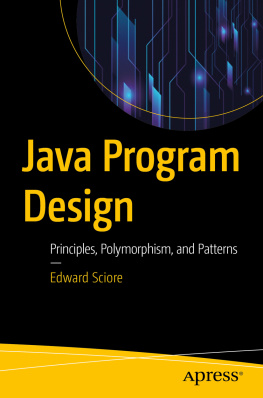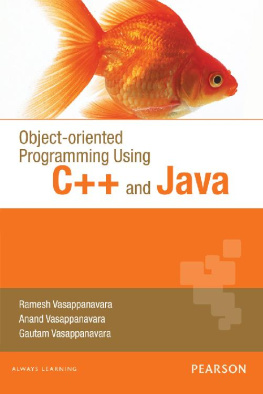Conrad Weisert [Conrad Weisert] - Object-Oriented Computation in C++ and Java: A Practical Guide to Design Patterns for Object-Oriented Computing
Here you can read online Conrad Weisert [Conrad Weisert] - Object-Oriented Computation in C++ and Java: A Practical Guide to Design Patterns for Object-Oriented Computing full text of the book (entire story) in english for free. Download pdf and epub, get meaning, cover and reviews about this ebook. year: 2013, publisher: Addison-Wesley Professional, genre: Computer. Description of the work, (preface) as well as reviews are available. Best literature library LitArk.com created for fans of good reading and offers a wide selection of genres:
Romance novel
Science fiction
Adventure
Detective
Science
History
Home and family
Prose
Art
Politics
Computer
Non-fiction
Religion
Business
Children
Humor
Choose a favorite category and find really read worthwhile books. Enjoy immersion in the world of imagination, feel the emotions of the characters or learn something new for yourself, make an fascinating discovery.
- Book:Object-Oriented Computation in C++ and Java: A Practical Guide to Design Patterns for Object-Oriented Computing
- Author:
- Publisher:Addison-Wesley Professional
- Genre:
- Year:2013
- Rating:4 / 5
- Favourites:Add to favourites
- Your mark:
Object-Oriented Computation in C++ and Java: A Practical Guide to Design Patterns for Object-Oriented Computing: summary, description and annotation
We offer to read an annotation, description, summary or preface (depends on what the author of the book "Object-Oriented Computation in C++ and Java: A Practical Guide to Design Patterns for Object-Oriented Computing" wrote himself). If you haven't found the necessary information about the book — write in the comments, we will try to find it.
This is the digital version of the printed book (Copyright2007).
Virtually all business, scientific, and engineering applicationsare heavily reliant on numeric data items. C++ and Java offerobject-oriented programmers unique flexibility and control over thecomputations required within such applications.
However, most books on object-oriented programming gloss over suchnumeric data items, emphasizing instead one-dimensional containersor collections and components of the graphical userinterface.
Object-Oriented Computation in C++ and Java fills thegap left by such books.
Drawing on more than twenty years experience as a softwaredeveloper, tester, consultant, and professor, Conrad Weisert showsreaders how to use numeric objects effectively.
Not limited to any language or methodology, the concepts andtechniques discussed in this book are entirely independent of oneschoice of design and coding methodology.
Practitioners of Extreme Programming, UML-driven design, agilemethods, incremental development, and so on will all develop thesesame data classes.
Whether you are a seasoned professional or an advanced computerscience student, this book can teach you techniques that willimprove the quality of your programming and the efficiency of yourapplications. The exercises (and answers) presented in this bookwith teach you new ways to implement the computational power ofC++, Java, and numeric data items.
Topics include
taxonomy of data types
developing and using object-oriented classes for numeric data
design patterns for commonly occurring numeric data types
families of interacting numeric data types
choosing efficient and flexible internal data representations
techniques for exploiting pattern reuse in C++
conventions for arithmetic operations in Java
numeric vectors and matrices
Conrad Weisert [Conrad Weisert]: author's other books
Who wrote Object-Oriented Computation in C++ and Java: A Practical Guide to Design Patterns for Object-Oriented Computing? Find out the surname, the name of the author of the book and a list of all author's works by series.

![Conrad Weisert [Conrad Weisert] Object-Oriented Computation in C++ and Java: A Practical Guide to Design Patterns for Object-Oriented Computing](/uploads/posts/book/119368/thumbs/conrad-weisert-conrad-weisert-object-oriented.jpg)



![Mark Lassoff [Mark Lassoff] - Java Programming for Beginners](/uploads/posts/book/119362/thumbs/mark-lassoff-mark-lassoff-java-programming-for.jpg)


